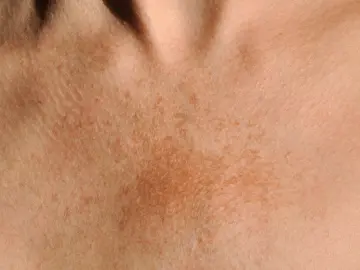What is pigmentation?
Pigmentation, or hyperpigmentation, also known as dark spots, age spots and sun spots, are uneven brown patches that occur on the face, hands, décolletage and shoulders. Larger than freckles, these areas of discolouration age us considerably.
What causes pigmentation?
Areas of uneven pigmentation are caused by sun exposure, specifically exposure to the UVA rays that penetrate deep into the skin to cause ageing.
When talking to Cosmopolitan, consultant dermatologist Dr Nick Lowe explained that “UVA stimulates the pigment cells to manufacture the pigment called Melanin. This is responsible for tanning and also unwanted dark patches”.
Sun spots, he says, can take anywhere between 10 and 20 years to develop, so even if you are trying your best to protect your skin now, you could start to notice those caused when you were a child.
In addition to sun exposure, the contraceptive pill and pregnancy can also trigger pigmentation in young women, resulting in further patchy dark spots.
How to prevent pigmentation
The best way to prevent future pigmentation is, of course, to wear a high factor UVA and UVB shielding sunscreen. Often, the sunscreen in regular foundation isn’t high enough to effectively protect the skin, so adding a higher factor is advisable. As well as protecting your skin from sun exposure with sunscreen, limiting the time that you actually spend in the sun is a necessary step to prevent further skin damage.
A further weapon in the fight against pigmentation is the antioxidant – the all important molecule that inhibits the oxidation in the tissue that causes ageing. Antioxidants mop up the free radicals that act like vandals in the skin. Free radicals are activated by sun exposure, or environmental pollutants such as cigarette smoke, as well as alcohol and sugars in our diets, Antioxidants are important in a healthy diet found in foods such as fruits and vegetables, as well as in quality serums and moisturisers, the antioxidant is not to be underestimated in its ability to prevent fight aging and sun damage.
The best treatments available
There are a range of treatments which can be helpful, which include prescription skin care, chemical peels and medical needling.
The best treatment for your pigmentation will depend very much on your age, life style and the nature and extent of your pigmentation. Expert assessment, diagnosis and advice are vital if the treatment is going to be successful for you.
For most, whilst treatments can deliver good results, they do not provide a cure for the underlying cause and all will require you to continue to protect your skin from the sun and use maintenance products to keep further pigmentation at bay.
Laser or intense pulsed light (IPL) treatment are a popular and well established treatment option for pigmentation. Practitioners will use a controlled pulse and wave length of light energy to target the brown pigment and shatter it, the cells recover and the pigment is disposed of by the body.
The treatment has been described by patients as like ‘hot fat spitting’ or ‘elastic bands flicking’, so the use of cooling gels and sprays can help with any discomfort.
Laser and IPL cannot be used on tanned skins or darker skin types, a series of treatments may be necessary and the pigment may appear darker before it improves.
For more information on laser and IPL treatment, including after effects and after care, be sure to download the Save Face factsheet.
What should you be paying?
Laser and IPL treatment costs vary depending on the extent of pigmentation. Prices for minor treatments involving small areas may cost around £100 per session, with intermediate and major treatment costing up to £400 per session.
Save Face
Poorly executed laser and IPL treatments can cause painful blistering, pigment changes or scarring which may be long lasting or permanent, so if you are considering either of these, then it is vital to visit a reputable clinic and be treated by a qualified practitioner with medical supervision.
Save Face is the UK’s first search engine that is able to connect you with qualified, safe and credible practitioners who have been assessed against strict Save Face objective standards. Use our search engine today to find a reputable practitioner near you.


